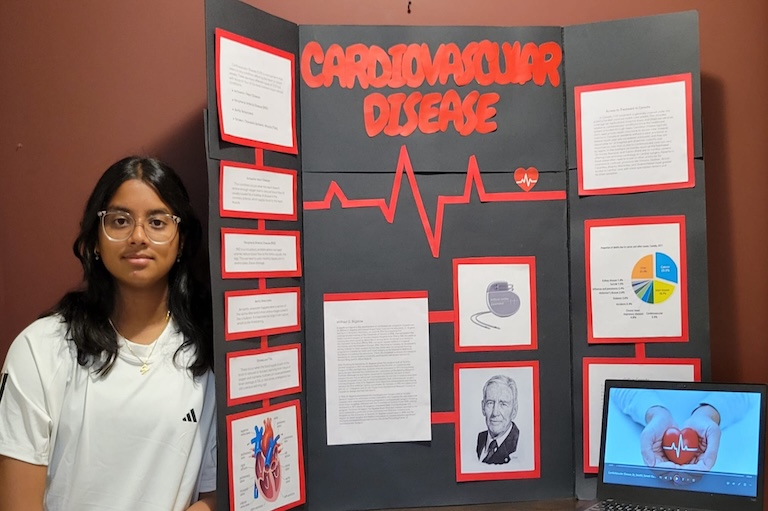Swathi S.

Cardiovascular Disease
Swathi S.
Saskatchewan Virtual Heritage Fair
Saskatoon, SK
Cardiovascular Disease (CVD) is a term for problems that affect the heart and blood vessels. Four common types are Ischaemic Heart Disease, Peripheral Arterial Disease (PAD), Aortic Aneurysms, and Strokes or mini-strokes (TIAs). Ischaemic Heart Disease happens when the heart doesn’t get enough oxygen because blood flow is blocked by plaque. PAD is when blood flow to the arms or legs is reduced, usually causing pain in the legs. Aortic Aneurysms happen when the main artery in the body gets weak and swells. If it bursts, it can be deadly. Strokes and TIAs happen when blood can’t reach the brain, which can cause serious brain damage.
Dr. Wilfred G. Bigelow was a Canadian heart surgeon who made big changes in heart care. He helped create the first artificial pacemaker in 1951 and started the first heart surgery training program in Canada. He worked at Toronto General Hospital and trained many new surgeons. He is remembered as the "Founding Father of Cardiovascular Surgery" in Canada.
In Canada, most people get heart treatment through public health care, which covers doctor visits, hospital stays, and medicine. But not everyone has the same access. People in remote areas often need to travel far for care.
CVD is the second leading cause of death in Canada and costs over $21 billion each year. Most adults have at least one risk factor, so it’s important to focus on preventing and treating heart disease to protect people’s health and save money.
What sources and evidence did you consult for your project? What different perspectives did they provide on your topic?
The sources I used were all websites. These websites offered different perspectives, including those of patients with cardiovascular disease and cardiologists. They provided information ranging from internal bodily processes to external issues such as finances, healthcare access, and geographic location.
What is the historical significance of your topic?
Cardiovascular disease is historically significant in Canada because it led to many medical advancements, such as the first artificial pacemaker, and it helped shape the country’s heart care system through pioneers like Dr. Wilfred G. Bigelow. In the short term, advances in treatments like the pacemaker and improved surgeries saved many lives and improved heart care across Canada. Over the long term, these medical discoveries helped train more doctors and made it easier for people to access heart treatments, which lowered the number of deaths from heart disease. However, this also created challenges like higher healthcare costs and an increasing number of people affected by the disease. Many Canadians, especially older adults, were impacted by heart disease. Medical advances have helped more people get treatment and live longer, but some people in remote areas still struggled to access care, leading to improvements in healthcare programs to reach more patients.
Why did you choose this topic?
The reasons I chose this topic were first because I was generally interested in this topic, and secondly because when I’m older I wish to pursue a career in this area of the medical field.

